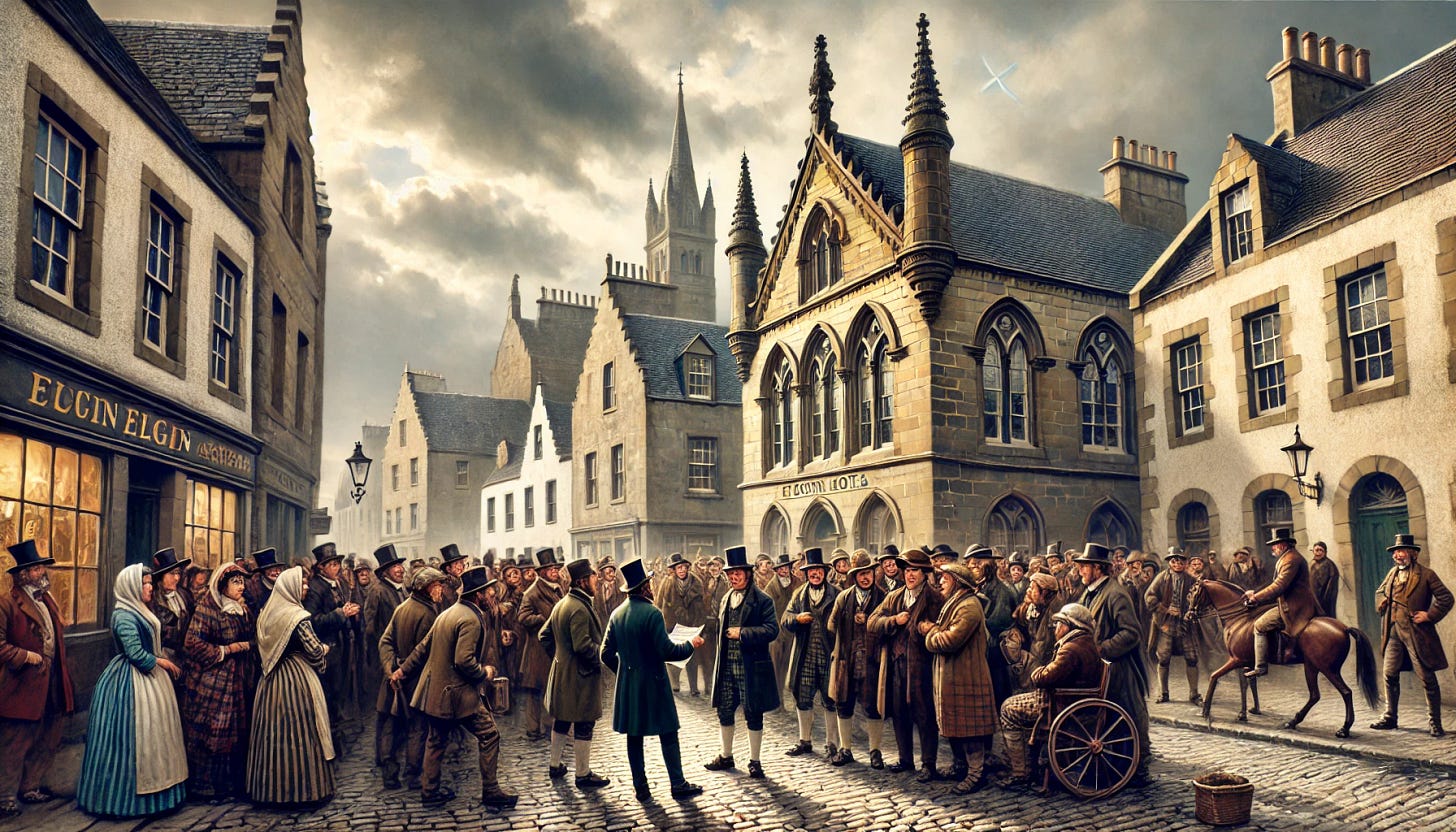In the early 19th century, Elgin was a small but influential royal burgh in Scotland, governed by a town council wielding disproportionate power over local and national politics. This power imbalance was a result of the electoral system, which placed significant authority in the hands of municipal representatives. For parliamentary elections, councils from several burghs—including Elgin, Cullen, Banff, Inverurie, and Kintore—selected a delegate to cast a vote on behalf of their community. These votes determined the election of Members of Parliament (MPs) for the Elgin Burghs constituency.
In Elgin, this process made the council an irresistible target for manipulation by powerful families. Two aristocratic factions, the Duffs of the Fife party and the Grants, dominated the region’s politics, each striving to secure influence through bribery, coercion, and outright corruption. The rivalry culminated in the infamous Raid of 1820, a chaotic and scandalous chapter in Elgin’s political history.
The Struggle for Power
The election of 1820 was one of the most hotly contested in the history of the Elgin Burghs. The stakes were high, as the MP selected would represent not just Elgin but also the surrounding towns. The Fife party, led by James Duff, the 4th Earl of Fife, was determined to maintain its grip on power. Opposing them were the Grants, another prominent aristocratic family with deep ties to the region.
At the heart of the battle were the trades’ guilds, or incorporated trades, which had gained representation on the council. These guilds—representing craftsmen like hammermen, glovers, and weavers—held key votes that could sway the council's decisions. Recognizing this, both factions aggressively courted the guild leaders, employing a mix of incentives, bribes, and coercion to win their support.
Corruption at Its Peak
The methods used to secure votes in 1820 shocked even those accustomed to the era's lack of electoral integrity. Both the Fife party and the Grants engaged in flagrant corruption, treating elections as a high-stakes auction where loyalty was bought with gifts, money, and property.
Bribes and Lavish Gifts
One of the most infamous examples was the "Psalm Book" incident. James Cattanach, the deacon of the wrights, was given a parcel by Lord Fife that was purported to contain a psalm book. Upon opening it, Cattanach discovered £300 in one-pound notes—a thinly disguised bribe to secure his vote for the Fife party.On the opposing side, the Grants used similar tactics. Deacon Steinson was awarded a valuable piece of property, described as a “well-biggit close.” This generous gift ensured his allegiance and remained a point of contention in the years that followed.
Rejected Bribes
Not everyone succumbed to the lure of money. Alexander M'Iver, the deacon of the shoemakers, became a local hero for his integrity. He reportedly refused an extraordinary offer of £2,000 and the liferent of a farm from the Grants. His stand against corruption earned him respect, but he was an exception in a deeply compromised process.Treating and Coercion
Beyond bribes, both factions engaged in "treating," a practice where voters and their families were plied with food, drink, and entertainment to win their favor. Coercion was also rampant, with factions intimidating guild leaders and other influential figures to sway their decisions.
The Raid of Elgin
As election day approached, the situation in Elgin escalated into outright chaos. Supporters of the rival factions clashed in the streets, with mobs forming to intimidate council members and disrupt proceedings. These disturbances gave the election its infamous name, The Raid of Elgin.
The council chambers became a battleground. Loyalists from both sides attempted to block opposing delegates from entering the building, while hired thugs ensured that council sessions were fraught with tension. Violence and intimidation became routine, eroding any semblance of legitimate governance.
The election result itself was mired in controversy. Votes were secured through blatant manipulation, and the public outcry over the corruption and lawlessness reached a fever pitch. The events of 1820 were a tipping point, exposing the systemic flaws in the electoral process and the unchecked power of local councils.
The Reform Act of 1832: A Turning Point
The Raid of Elgin, alongside similar incidents in other parts of Britain, highlighted the urgent need for electoral reform. The public demanded changes to curb corruption and ensure fair representation. These calls were answered with the Reform Act of 1832, which reshaped the political landscape of the United Kingdom.
Key reforms introduced by the Act included:
Expansion of the Franchise: Voting rights were extended to more citizens, reducing the influence of small, elite groups like the town councils.
Redistribution of Parliamentary Seats: Rotten boroughs—areas with few voters but disproportionate representation—were eliminated, and seats were reallocated to reflect population changes.
Direct Elections: Power shifted away from town councils, with MPs now elected directly by the people.
For Elgin, the Act marked the end of an era. The council’s political dominance was diminished, and the trades’ guilds, once powerful arbiters of elections, became ceremonial bodies. The newfound transparency in the electoral process brought stability to the town, though the scars of the Raid lingered in local memory.
Legacy of the Raid of Elgin
The Raid of 1820 remains a cautionary tale about the perils of concentrated power and unchecked corruption. It serves as a reminder that democratic systems must be vigilant against the forces of greed and partisanship.
Today, Elgin’s quiet streets and historic landmarks stand in stark contrast to the chaos of its past. The events of 1820 are a distant memory, but they continue to offer lessons about the importance of accountability and transparency in governance.





